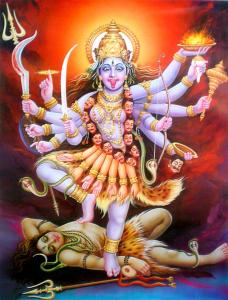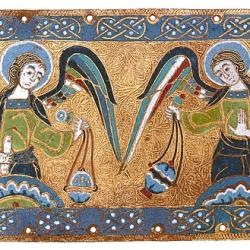The Day I Met Kali
A Meditation on a Naturalistic Mysticism
A sermon delivered at the
Orange Coast Unitarian Universalist Church
Costa Mesa, California
6 May 2018
James Ishmael Ford
In my mid-teenaged years, I discovered the 19th Century Hindu Saint Ramakrishna. Mainly through the writings of Aldous Huxley and Christopher Isherwood. They were deeply tangled up with a Hindu mission, the Vedanta Society. Isherwood in particular wrote a lot on the subject. And in one of his books I read an account about how Ramakrishna prayed constantly for a vision of his goddess, in his case Kali (4), the Divine Mother. He wanted to know her as she was. He wanted to see her with his own eyes.
I personally understood this prayer. It was my own longing from some aching place in the pit of my being, to know whether God was true, was real or simply the projection of human fears and hopes into the sky. I was looking for some sort of simple verification. Was my mother’s fundamentalist God with white robe, a flowing beard and bolts of lightning in one hand, or my father’s flat out denial of the existence of any deity, right? I never got a response to that prayer, more or less, I admit, inclining me to my father’s view.
But Ramakrishna’s prayer was answered. One day unbidden, she came to him. In some form of waking vision as he watched, she arose out of a river and walked toward him. As she walked the goddess swelled out in pregnancy, gave birth – and then – ate her child. Witnessing all this he slipped into a fever of ecstasy. As a young man, really, still basically a boy, I was shocked that this would be a turning point in this revered saint’s life. And, I had no idea what to make of Kali. It all seemed so awful. But, I filed this story away somewhere in the recesses of my heart, never completely forgetting it.
Then, some years later, after I’d left the Buddhist monastery where I’d been living, I went to rural Oregon to visit my brother. While there, I took a walk where I found myself at the edge of a genuine wilderness. It was wonderful, if also, a bit eerie to a convinced city boy. I sat in the shade on a large flat rock beside a creek. All these years later I can still taste the air from that day, I can smell the warmth and the vegetation, the way light played across everything. At the very same time the place was deeply silent and abuzz with life.
Then in the midst of it all I noticed there was a sunny spot on a good-sized rock in the middle of the creek. I watched as a large fat toad hopped up, settled down, and sunned itself. All was right with the universe. What I didn’t notice until just as it struck was the snake. My heart leapt into my throat, I was frozen to the spot as I witnessed it all happen. In a bloody moment snake and frog fell behind the rock out of sight. A small blessing. Then, minutes later the snake slithered up onto the rock in the same place, with a large swelling in its middle, and lazed in the same sunny spot.
And, I recalled Kali and Ramakrishna and that horrific, and now somehow for me, personally, deeply beautiful vision. In a moment where I surrendered analysis and just witnessed, everything, joy and sorrow, calm and ecstasy, played across my heart. It was a moment that held the entire cosmos, excluding nothing. I felt my heart grabbed like that snake grabbed the frog. And I realized while sitting there in the shade witnessing it all, that I, too, was swallowed by the world itself. And I realized in some deep, visceral way, I was the world itself. I met Kali, and she was me. No part of the great mess, frog, snake, the world, hurt or joy was alien to me. It was me.
The intense moment passed. As all things do. In fact, I’d had some experiences of a binding depth, some mysterious intimacy with the world before. Living in a Zen Buddhist monastery puts one in the way of such things. And, since, as well. The spiritual life is littered with stories.
So, what to make of it? What is religion, spirituality, really all about? What is the problem that religions are meant to address? And. What is the goal to be won? I suggest the problem that births the heart of religions, all of them, is some common-as-dirt, and totally human, sense of separation, of isolation. And, the goal of religions, all of them, is a quest for healing of that sense of separation, of that haunting and sad isolation. And, the healing that is found is some profoundly personal experience of connection. The words to describe that sense of intimacy appear nearly endless.
Now, despite my beginning this reflection by describing an ecstatic vision, what I will call here an experience of “unitive insight,” I’m actually a pretty this-worldly kind of person. And, and this is important, I find our sense of a problem of isolation and our urging toward some kind of healing, are completely encountered within this physical and for us biological world. For us as mammals, more specifically as a herding variety of great apes, capable of profound affection for others, but also with an unfortunate penchant for violence. Us. We are the very stuff that creates the problem and can heal it.
There is no scientific consensus about the biological basis of this unitive insight.
Although some interesting hypothesis are emerging. One of my favorites suggest we have two ways of perceiving. The one is expressed as our ability to focus on things. Think of the parts of our consciousness that allows us to invent a hatchet. The other is our ability to generalize. Think of that aspect of our consciousness which allows us to walk in the woods, aware of the possibility of a saber tooth tiger jumping out of the darkness. Each seems associated with brainwave patterns. Their functioning can be traced in an MRI.
One suggestion about that intuitive insight is that there can be an oscillation between these two patterns of our consciousness, specific and general, that might be associated with some meditation practices, but, also seems to just appear in human minds spontaneously. The oscillation can become so rapid a new third perspective emerges. The unitive insight. Now, probably this isn’t the right physiological description. But, the hypothesis is evocative. What I feel sure of, is that awakening into a unitive perspective, what is also called the mystical perspective, is expressed biologically within our human minds.
Now, that said, this is important. Because there is almost certainly a biological explanation for how we experience this unitive insight doesn’t mean it isn’t real. It sure seems real. It certainly has real-world consequences. The experience has both a spiritual and an ethical facet. The spiritual, if you will, shifts our stance in this world, bringing with it, in most cases, a settlement of the heart into a kind of serenity, a kind of peace in the midst of chaos. The ethical can be summarized in the golden rule. It is how one acts when one sees that we are in fact intimately connected.
Contemplating what might be the overarching experience of unity, I find pantheism a really good philosophical stance. The word pantheism was coined by an eighteenth-century writer John Toland in an essay about the philosopher Baruch Spinoza and brings together two Greek words meaning “all” and “god.” All and everything is the divine. What precisely this means seems to be up for grabs. Lots of different ways to nuance this insight of our profound intimate connections. Some with very interesting bells and whistles attached. And beyond the time we have here.
The kind of pantheism that has caught my heart, within the contexts of finding that unitive insight, that mystical insight which transforms hearts and the direction of lives, is sometimes called naturalistic Pantheism. In this view there is simply one substance that makes up the world, there is no spiritual and material divide.
And, this is in fact the pantheism of Spinoza and Toland and before them of the Greek Stoics and, I would suggest like the author(s) of the Dao De Jing and Zhuangzi, the writer who told us of the man who dreamed he was a butterfly, or, perhaps a butterfly dreaming it was a man. We see it in many forms of Buddhism, particularly Zen. Actually, it can be found in the mystical traditions of the world’s faiths running from Judaism, to Christianity, to Islam, to Hinduism, especially, I would add, Vedanta, to the several varieties of Chinese religion. To begin a list. This pantheistic perspective is also the baseline spiritual stance of many Transcendentalists. Emerson and particularly Thoreau, come immediately to mind.
Think of it as a naturalistic mysticism at the heart of religions, a naturalistic perennialism.
We’re also wading into dangerous waters here. The unitive experience tells us how intimately connected we all and the world are, and often it leads people to act on behalf of others. When this leads to charity, all is pretty good. As the late bishop Dom Helder Camara noted, “When I give food to the poor, they call me a saint.” But, it sometimes leads to a step further, yet. And when people like the good bishop then ask why people are poor, well, then that violates a cardinal aspect of normative organized religion, supporting the status quo. A major aspect of religions has always been crowd control. So, the mystics are at the edge of their traditions, always. And their teachings are often suppressed, and sometimes, if they’re too noisy they are dealt with, and, often, harshly. As I said, dangerous waters. And fair warning.
This unitive experience definitely is not nice. It is something terrible and wondrous. It begins as a new way of seeing. It is the heart that sees the story of Ramakrishna and Kali as one’s own, of that frog and snake as one’s own.
The poet and old Zen hand Gary Snyder sings another angle into this mystery that goes into the wound and comes out a mysterious healing.
Eating the living germs of grasses
Eating the ova of large birds
the fleshy sweetness packed
around the sperm of swaying trees
The muscles of the flanks and thighs of
soft-voiced cows
the bounce in the lamb’s leap
the swish in the ox’s tail
Eating roots grown swoll
inside the soil
Drawing on life of living
clustered points of light spun
out of space
hidden in the grape.
Eating each other’s seed
eating
ah, each other.
Kissing the lover in the mouth of bread:
lip to lip.
Something terrible. Something beautiful. All of it bound up together.
A communion. A feast. Kind of like a church potluck.
The mystery that is our lives.
Revealed in the breaking of bread.













